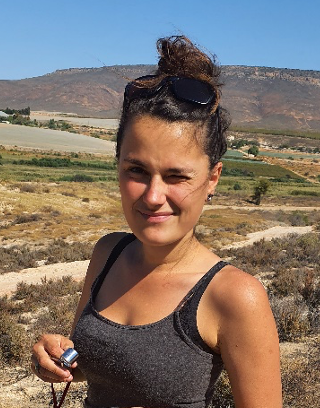Doctorante – Pôle thématique SYTES – Groupe de recherche FORETS et TRAP
PhD student
Projet européen ChemArch (ITN International Training Network ; EJD European Joint Doctorate
This project received funding from the European Union’s Horizon 2020 research and innovation programme under the Marie Skłodowska-Curie grant agreement No 956351.
Directrice de thèse : Martine Regert (UMR 7264 CEPAM)
Co-directrices de thèse : Aimée Little (University of York) et Rebecca Stacey (British Museum)
Projet de Thèse
Tracking adhesive technologies from the Late Glacial to Early Holocene
(Explorer les technologies des substances adhésives depuis la fin du Pléistocène jusqu’à l’Holocène récent)
Keywords : adhesive residues ; birch tar ; resins ; experimental archaeology ; analytical chemistry
Mots clefs : résidus adhésifs ; brai de bouleau ; résines ; archéologie expérimentale ; chimie analytique
In Europe, birch tar is considered a universal adhesive during prehistoric times, but archaeological data is scarce and scattered. As part of this thesis project, the aim will be to determine the raw materials used in Holocene adhesives, to understand their functions in relation to their physicochemical properties and to better understand the know-how and traditions related to these substances, considering birch tar but also the diversity of products that may have been exploited (coniferous resins and tars, beeswax, bitumen, etc.). The corpus considered, partly already established but destined to be completed within the framework of the doctorate, consists of adhesive materials preserved in different contexts across Europe (Mesolithic sites in northern Europe, Neolithic lacustrine contexts, Neolithic sites in the Mediterranean domain and recently unearthed collections from protohistoric sites).
In methodological terms, the project will include the chemical characterization of adhesive samples from various objects (lithic and bone tools, ceramic vessels) and, in a new and innovative way, the measurement of the mechanical properties of adhesive products produced experimentally in order to understand the production methods, choices and management of natural substances used for several purposes (fitting materials, repairing or waterproofing ceramic vessels or other objects, etc.). An essential aspect of the project is to establish the availability of raw materials used in the composition of adhesive materials (birch, pine, etc.) and to determine whether other materials such as beeswax, ocher, charcoal of wood, etc. have been used as additives to improve the properties of the adhesives used.
En Europe, le brai de bouleau est considéré comme un adhésif universel pendant la préhistoire, mais les données archéologiques sont rares et dispersées. Dans le cadre de ce projet de thèse, il s’agira de déterminer les matières premières utilisées dans les adhésifs holocènes, d’appréhender leurs fonctions en lien avec leurs propriétés physico-chimiques et de mieux comprendre les savoir-faire et les traditions liées à ces substances, en considérant le brai de bouleau mais aussi la diversité des produits ayant pu être exploités (résines et goudrons de conifère, cire d’abeille, bitume, etc.). Le corpus considéré, en partie déjà établi mais voué à être complété dans le cadre du doctorat, est constitué de matières adhésives conservées dans différents contextes à travers l’Europe (sites mésolithiques du nord de l’Europe, contextes néolithiques lacustres, sites néolithiques du domaine méditerranéen et collections récemment mises au jour issues de sites protohistoriques).
En termes méthodologiques, le projet comprendra la caractérisation chimique d'échantillons d'adhésifs provenant d'objets diversifiés (outils lithiques et osseux, récipients en céramique) et, de façon inédite et novatrice, la mesure des propriétés mécaniques de produits adhésifs fabriqués expérimentalement afin de comprendre les méthodes de production, les choix et la gestion de substances naturelles utilisées à plusieurs fins (matériaux d’emmanchement, réparation ou imperméabilisation de récipients en céramique ou d'autres objets, etc.). Un aspect essentiel du projet consiste à établir la disponibilité des matières premières entrant dans la composition des matériaux adhésifs (bouleau, pin, etc.) et à déterminer si d'autres matériaux tels que la cire d'abeille, l'ocre, le charbon de bois, etc. ont été utilisés comme additifs pour améliorer les propriétés des adhésifs exploités.
Cursus Universitaire
Depuis 2021 : PhD – Université Côte d’Azur, Nice (France) et University of York (Royaume-Unis), Projet européen ChemArch (ITN International Training Network ; EJD European Joint Doctorate) : Tracking adhesive technologies from the Late Glacial to Early Holocene
2021 : Master of Science – Archaeometry – University of Tübingen (Allemagne)
2019 : Bachelor of Arts – Archaeology – University of Freiburg im Breisgau (Allemagne)
Publications
Schmidt, P., Koch, T.J., Blessing, M.A., Karakostis, F.A., Harvati, K., Dresely, V., Charrié-Duhaut, A., 2023. Production method of the Königsaue birch tar documents cumulative culture in Neanderthals. Archaeological and Anthropological Sciences. 15, 84. https://doi.org/10.1007/s12520-023-01789-2
Schmidt, P., Koch, T.J., Tennie, C. Reply to Paul RB Kozowyk: Interpreting the complexity of archaeological adhesives may lead to misconceptions about early humans. Proceedings of the National Academy of Sciences 120, 7 (2023). https://doi.org/10.1073/pnas.2300325120
Koch, T.J., Schmidt, P. Adhesive Strength and Rupture Behaviour of Birch Tars Made with Different Stone Age Methods. Journal of Paleolithic Archaeology 6 (2023). https://doi.org/10.1007/s41982-023-00135-1
Schmidt, P., Koch, T.J., February, E. Archaeological adhesives made from Podocarpus document innovative potential in the African Middle Stone Age. Proceedings of the National Academy of Sciences 119, 40 (2022). https://doi.org/10.1073/pnas.2209592119
Schmidt, P., Koch, T.J., Berthold, C., Lauxmann, F., & Nickel, K. G. The evolution of strength, elasticity and rupture behaviour of birch tar made with ‘double-pot’ techniques during tar cooking. Archaeometry, 1– 14 (2022). https://doi.org/10.1111/arcm.12820
Koch, T.J., Schmidt, P. The unique laurel-leaf points of Volgu document long-distance transport of raw materials in the Solutrean. Archaeological and Anthropological Sciences 14, 101 (2022). https://doi.org/10.1007/s12520-022-01572-9
Koch, T.J., Schmidt, P. A new method for birch tar making with materials available in the Stone Age. Scientific Reports 12, 413 (2022). https://doi.org/10.1038/s41598-021-04161-3
Schmidt, P., Blessing, M.A., Koch, T.J., Nickel, K.G. On the performance of birch tar made with different techniques. Heritage Science 9, 140 (2021). https://doi.org/10.1186/s40494-021-00621-1
Koch, T.J., Schmidt, P. The formation conditions of birch tar in oxygen-depleted environments. Archaeological and Anthropological Sciences 13, 92 (2021). https://doi.org/10.1007/s12520-021-01352-x
Extrait de la production scientifique (HAL)
Filtrez par type
Ou filtrez par année


